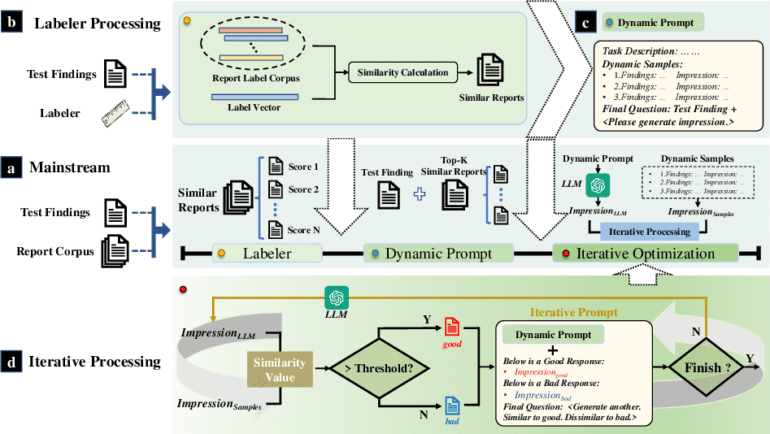TL;DR:
- ImpressionGPT leverages iterative optimization to enhance radiology report summaries.
- Neural networks and deep learning techniques improve summary generation compared to traditional methods.
- ChatGPT is trained using similarity search algorithms and parallel reports to understand imaging manifestations.
- The framework includes dynamic prompts, iterative refinement, and domain-specific optimization.
- The feasibility of Large Language Models (LLMs) for radiological summaries is investigated.
- Fine-grained assessment measures are employed to evaluate the model’s output.
- Future directions involve incorporating domain-specific data, addressing privacy concerns, and involving human specialists for feedback.
Main AI News:
In today’s information-driven world, the demand for effective and accurate text summarization models is skyrocketing, especially in the medical field. As volumes of digital textual information continue to expand exponentially, condensing lengthy pieces of writing into concise overviews while retaining their meaning and value becomes paramount. For years, Natural Language Processing (NLP) research has focused on the challenge of text summarization.
Exciting advancements have been made in the field through the introduction of neural networks and deep learning techniques, particularly sequence-to-sequence models using encoder-decoder architectures. Compared to traditional rule-based and statistical methods, these approaches have produced more natural and contextually appropriate summaries. However, the task becomes even more complex when it comes to preserving contextual and relational features while ensuring precision in therapeutic settings.
Recognizing the potential of ChatGPT, researchers have harnessed its power to summarize radiological reports. Leveraging ChatGPT’s in-context learning capability and the ability to continually improve through interaction, a groundbreaking iterative optimization method has been developed using rapid engineering. This iterative optimization framework takes advantage of similarity search algorithms to construct a dynamic prompt that incorporates semantically and clinically comparable preexisting reports. By training ChatGPT with these parallel reports, it becomes proficient in understanding textual descriptions and summaries of similar imaging manifestations.
Key Contributions
1. Similarity search: By enabling in-context learning of a Language Model (LLM) with sparse data, researchers have developed a dynamic prompt that includes the most relevant information for the LLM. This is achieved by identifying the most comparable cases in the corpus, ensuring a comprehensive learning experience.
2. Dynamic prompting system: To facilitate iterative optimization, a dynamic prompting system has been created. The iterative prompt evaluates the LLM-generated replies and provides additional directions for subsequent iterations, enabling ChatGPT to refine its answers continuously.
3. Domain-specific LLM tweaking: A novel approach has been proposed to capitalize on domain-specific information for LLM optimization. This methodology proves invaluable when developing domain-specific models quickly and effectively from an existing LLM.
Methods
Variable Prompt: Dynamic samples leverage semantic search to acquire examples from a report corpus that are comparable to the input radiology report. The final query consists of a pre-defined inquiry paired with the “Findings” section of the test report, along with a task description that outlines its role.
Optimization via Iteration: The iterative optimization component is a game-changer. It allows ChatGPT to refine its responses iteratively by employing an iterative prompt. Crucially, for high-stakes applications like radiology report summaries, a response review procedure ensures the quality of the replies.
Investigating the Feasibility
Researchers have delved into the feasibility of utilizing Large Language Models (LLMs) for summarizing radiological reports. They enhance the input prompts based on a small number of training samples and employ an iterative method. By mining the corpus for suitable instances that allow LLMs to learn in context, interactive cues are provided. Furthermore, an iterative optimization technique is implemented to further enhance the output. This procedure involves teaching the LLM how to recognize good and negative responses through automated evaluation feedback. Compared to approaches relying on vast amounts of medical text data for pre-training, this strategy has demonstrated its superiority. Moreover, it serves as a stepping stone to developing domain-specific language models in the realm of modern artificial general intelligence.
Fine-Tuning Assessment Measures
As the ImpressionGPT iterative framework took shape, researchers identified the challenge of assessing the quality of the model’s output responses. They hypothesized that the discrepancies in scores stem from the vast differences between domain-specific and general-domain training text for LLMs. To gain a better understanding of the obtained outcomes, fine-grained assessment measures were employed, enhancing the examination of specific details.
Future Directions
To further incorporate domain-specific data from both public and local sources, ongoing optimization efforts will focus on addressing data privacy and safety concerns, particularly when dealing with multiple organizations. Additionally, the integration of the Knowledge Graph is being considered to adapt the prompt design to current domain knowledge. Lastly, human specialists, including radiologists, will be actively involved in the iterative process, providing objective feedback on the system’s outcomes. By combining the expertise and perspective of human specialists with LLM development, more precise results can be achieved.
Conclusion:
The development of ImpressionGPT’s iterative optimization framework for radiology report summaries marks a significant advancement in the market. By utilizing neural networks and deep learning techniques, this approach produces more contextually appropriate summaries compared to traditional methods. The integration of similarity search algorithms and parallel reports enhances ChatGPT’s understanding of imaging manifestations, leading to improved accuracy. The iterative refinement process ensures continuous improvement, making it highly valuable for high-stakes applications like radiology. With ongoing efforts to address privacy concerns, incorporate domain-specific data, and involve human specialists, the market can expect more precise and reliable radiology report summaries, revolutionizing the field and benefiting both healthcare providers and patients alike.

